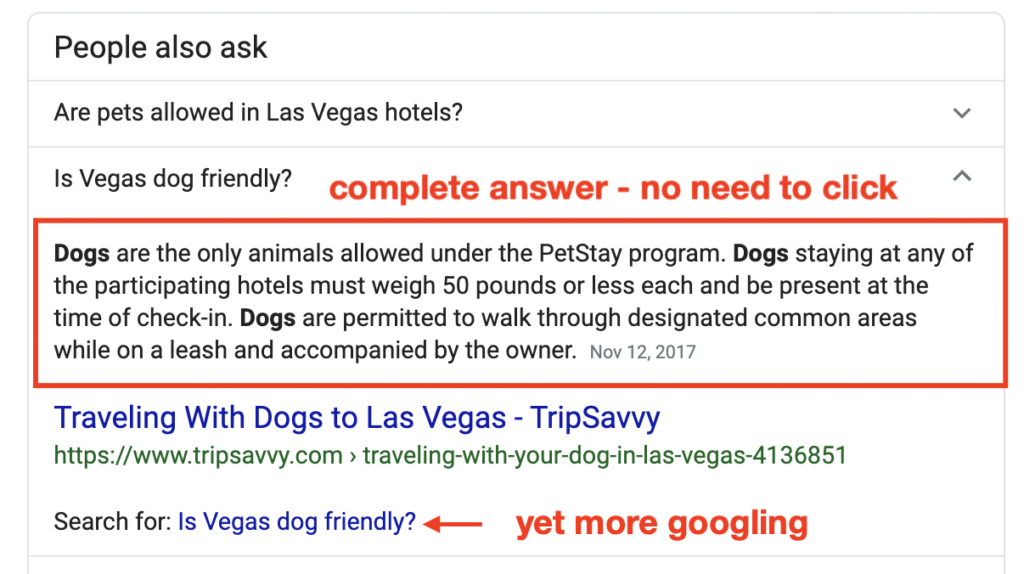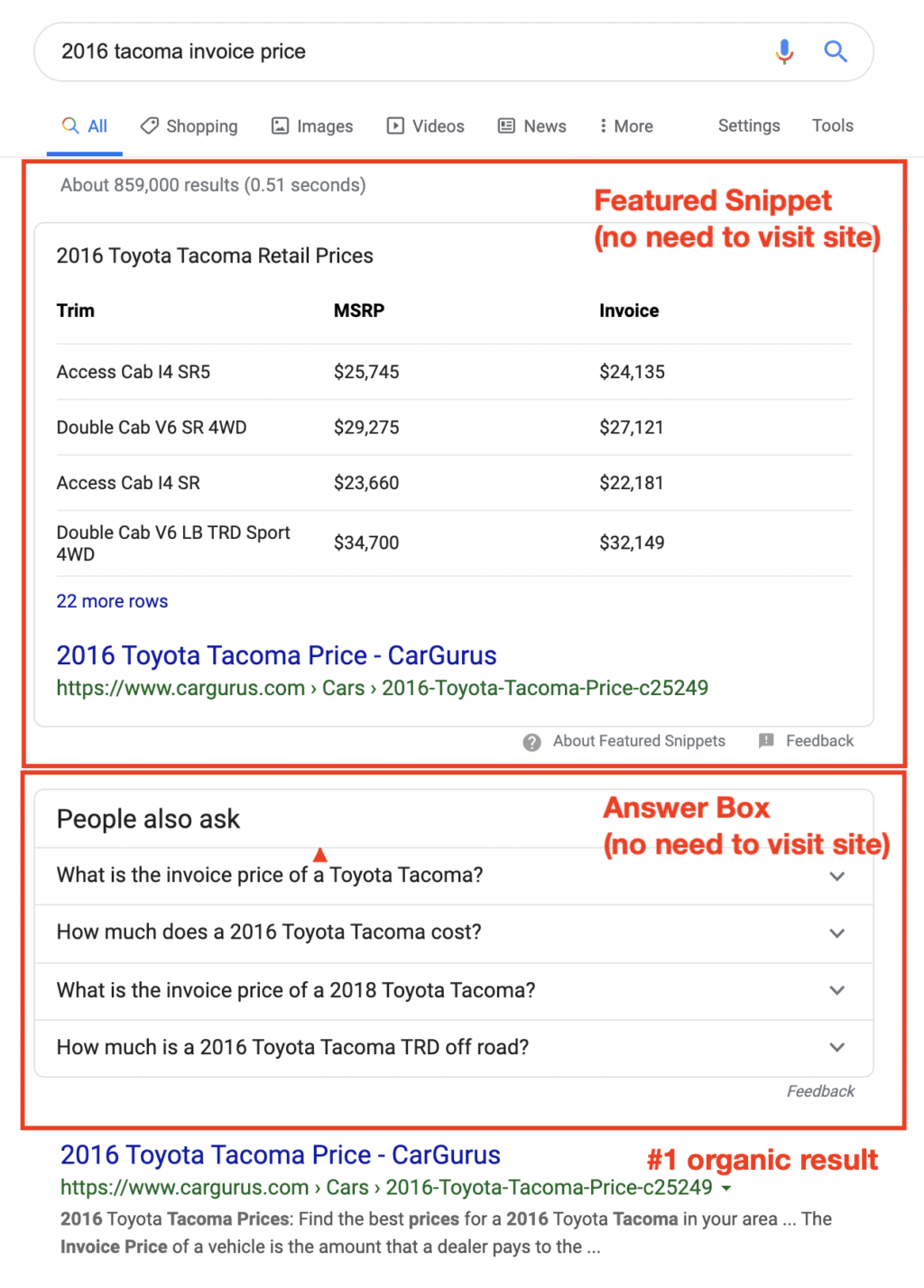Zero-Click Searches: How to Get Back Your Lost Google Traffic
More than 50% of Google searches end without an organic click – and that’s a huge threat to our websites.
These zero-click searches are resulting in growing losses in both revenue and leads, making Google everyone’s competitor.
On February 26, I moderated a sponsored Search Engine Journal webinar presented Andreas Dzumla, CEO and Co-founder at Longtail UX.
Dzumla showed simple, proactive steps that marketers can take today to recover traffic lost to zero-click searches.
Here’s a recap of the webinar presentation.
The Rise of Zero-Click Searches

The rise of zero-click searches is an issue of growing importance to members of the SEO and SEM community.
There was a time when all a search engine result page (SERP) pointed to 10 blue links with a few ads in between.
Nowadays, the SERPs are filled with other features that don’t lead to websites.

In November 2019, Rand Fishkin highlighted the challenge that SEO pros are facing:
“The largest source of traffic on the web — free and paid — is becoming a walled garden, intent on keeping people on its own properties.”
This is happening to SERPs for various industries and verticals, including:
- Hotels


- Finance: According to WordStream, the CTR of a #1 SERP result falls by 39% when a featured snippet is present.

- Automotive

A similar scenario is happening on the PPC side.
On top of all the challenges in the landscape (including increasing competition and complexity, limited control with automation, and tech limitations and content creation for landing pages), paid search is likewise becoming a walled garden because of the “Amazonification” of the SERPs.
For instance, Google Shopping is attempting to provide a better experience for users.
Instead of having a number of links where users click through in order to go see different products here, now Google Shopping provides many more products in one click.

While good for user experience, this also leads to some issues from an advertiser’s perspective.
There is more pogo-sticking and more competition on prices.
Plus, having all transactions done within Google means you’re paying for traffic but users never actually land on your website.
You’ll be unable to:
- Promote brand experience.
- Do list building and retargeting.
- Do cross-selling.
- Have a good margin.
Google is threatening to turn ecommerce websites into mere suppliers, by forcing us to compete on price alone (and even starts handling the checkout).
A Silent Threat: Google’s Competition with Websites & the ‘Amazonification’ of Search
Google’s competition with websites and the “Amazonification” of search is a silent threat for marketers. Here’s why.
SEOs Have Been Looking at the Wrong Metrics
It’s because SEO pros have been looking at the wrong metrics:
- Rankings
- Visibility
BERT will only make things worse for marketers.
The effect of this algorithm to SEO came under the radar as most SEO tracking tools aren’t that good in the long-tail.
BERT will actually mean:
- More featured snippets and better answer boxes.
- Less CTR to websites.
- Profit for Google.
PPC Pros Have Gotten Used to Spending More for Less
PPC pros have gotten used to spending more for less due to:
- Increasing competition.
- Dependence of product detail pages (PDPs).
The Blame Game
Instead of blaming Google, we need to be reminded of the following truths:
- Google’s customers in SEO are not websites and digital marketers – but the searcher. In PPC, the serve digital marketers and the searcher.
- Google tests SERP features algorithmically – so the numbers tell them they are right.
- Google provides automated content and covers the long-tail because you don’t do it.
But when you think about it, Google isn’t entirely faultless.
- Google’s own Analytics doesn’t tell you which keywords provide 97% of SEO traffic and revenue (“not provided”) – forcing search marketers to rely on visibility and rankings from third-party tools.
- Google Search Console shows Impressions and Clicks only for top 1,000 KWs – and it’s not linked to Conversions and Revenue.
- A Groupon study found that Google attributes up to 60% of organic traffic as “Direct”.
Solving the SEO Problem
Despite the challenges, there are solutions to get back your lost traffic from zero-click searches.
Rand Fishkin provided some solutions over at SparkToro, including (but not limited to):
- Institutional action.
- Strategic keyword selection: Done manually, this can be expensive, time-consuming and deliver an uncertain outcome.
But there is a better way to approach this: by having automation that will:
- Target long-tail keywords at scale.
- Know when you provide better content than Google.
- Make informed decisions based on data.
1. Keyword Research with First-Party Data
First-party data beats third-party data any day of the week.
For companies that run Google Ads, this would be available in the Search Terms report.
However, SEMrush, Ahrefs, Keyword Planner and other tools are great if you don’t have first-party data.
2. Look at Brand vs. Non-Brand SEO
How much revenue your website made on non-brand SEO is something you can’t look up in any tool or in Search Console or Google Ads, but it’s an important area to help you plan on your strategy.
3. Keyword-Level ROI Insights for SEO & Test Keywords at Scale
Having a long-tail keyword strategy is crucial in order to compete with Google.
Creating better long-tail content and providing better UX than Google can reward you with better search visibility.
All these are now possible with platforms such as Longtail UX.
What You Can Do
In a Google world where half your on-SERP visibility is at risk, if you can “fail” cheap, you can keep winning.
To do this, start automating:
- Page creation.
- Custom user experience.
- Contextual interlinking.
- Measure SEO ROI at the keyword-level.
Solving the PPC Problem
Everyone else thinks that focusing on product detail pages (PDPs) in paid search is the key.
But there’s an alternative. Using automation, you can:
- Let each keyword create their own matching landing page.
- Let the landing pages create their own campaign structure.
These may result in better conversions and ROAS, among others.
Q&A
Here are just some of the attendee questions answered by Andreas Dzumla.
Q: When it comes to reporting, you mentioned that SEO’s should shift away from Rank and Visibility. What should be the metric(s) for reporting moving forward. Aside, from analytic tools like GA/Abode Analytics to measure those ordinary website metrics.
Andreas Dzumla (AD): Revenue and conversions, using Landing Page reports.
You can see your last 12 months – plus the opportunity for growth by implementing Longtail UX – by running the Scorecard at https://scorecard.longtailux.com/.
Q: Does the solution integrate with Shopify Plus and BigCommerce?
AD: Yes, Longtail UX works with Shopify Plus and BigCommerce.
Q: Automation is great for some tasks, but Google might penalize you if you don’t use it as they want you to – mostly around smart bidding. This is not a great fit for all campaigns. Low volume/high value conversions are best controlled manually IMO.
AD: We run hundreds of thousands of long-tail landing pages. No SKAG (single keyword ad group) run to those pages has ever gotten a penalty.
Q: What’s the critical mass needed for the long tail to be effective? I have a client site with only 100 pages.
AD: Automated – 1,000 pages.
Q: Does this affect professional services (veterinarian) like it does if you’re selling products?
AD: Yes, in fact lead generation websites often do better with Longtail UX because Google doesn’t put as many on-SERP distractions on non-product related searches.
Q: What is the approach to identify and reduce click fraud?
AD: We don’t deal with much of this, but it would be tough to get click fraud on a Longtail UX landing page.
We only run SKAGs at them, and they’re usually for keywords that get so little search volume that it would be hard for a competitor to find and defraud them. (Most of the keywords our customers target get <100 exact searches per month.)
Q: Is it not a risk to organic SEO rankings to have thousands of landing pages? Will these be crawlable or hidden just for PPC ads?
AD: Not a risk. We roll out pages for Organic SERPs at a rate of 20% of indexed pages on the website. All long-tail landing pages intended for collection of PPC traffic are noindex, nofollow. (So no need to worry about crawl budget in either case.)
Q: Where are the best places to get first party data?
AD: The Search Terms report from GA. The Longtail UX Scorecard shows you everything you need to know in about 30 seconds of work.
Q: Will automating the page creation process sacrifice design and UX for ranking/conversion?
AD: No. Longtail UX landing pages convert on average 50-100% higher than product detail pages.
From the perspective of the searcher, she’s just grateful somebody finally created a landing page to serve her very personalized search.
Q: Amazing statistics of how few SEOs look at keyword data. How are you determining clicks or revenue for featured snippets?
AD: That report comes from Tim Soulo at Ahrefs: https://ahrefs.com/blog/featured-snippets-study/
Q: You won’t see Search Terms reports unless you’re running ads.
AD: That’s right. To be a prospect for Longtail UX, you need to be running at least $20,000/month in paid search ads.
Q: How do you know an SEO long-tail landing page focus is going to be a better user experience than what could be generated in the Google Answer Box?
AD: You don’t! That’s why you testing thousands of long-tail landing pages – and then cutting the poor performers (a.k.a. “failing cheap”) is the name of the game today.
Q: Should we use Google Ads search term reports for SEO keyword research?
AD: Because Search Terms reports give you the exact keyword, the exact amount of traffic, the exact conversion rate, the exact amount of revenue… all stuff that the Organic report doesn’t give you. Then you can find those gold nugget keywords that need better matching content, products, reviews, etc.
Q: By automating landing pages at scale whats the balance with this vs. crawl budget?
AD: We recommend limiting the number of Longtail UX landing pages to 20% of your current number of indexed pages.
[Video Recap] Google’s Hogging Half YourTraffic: How to Get It Back
Watch the video recap of the webinar presentation and Q&A session.
Image Credits
In-Post Image: Longtail UX All screenshots taken by author, March 2020
